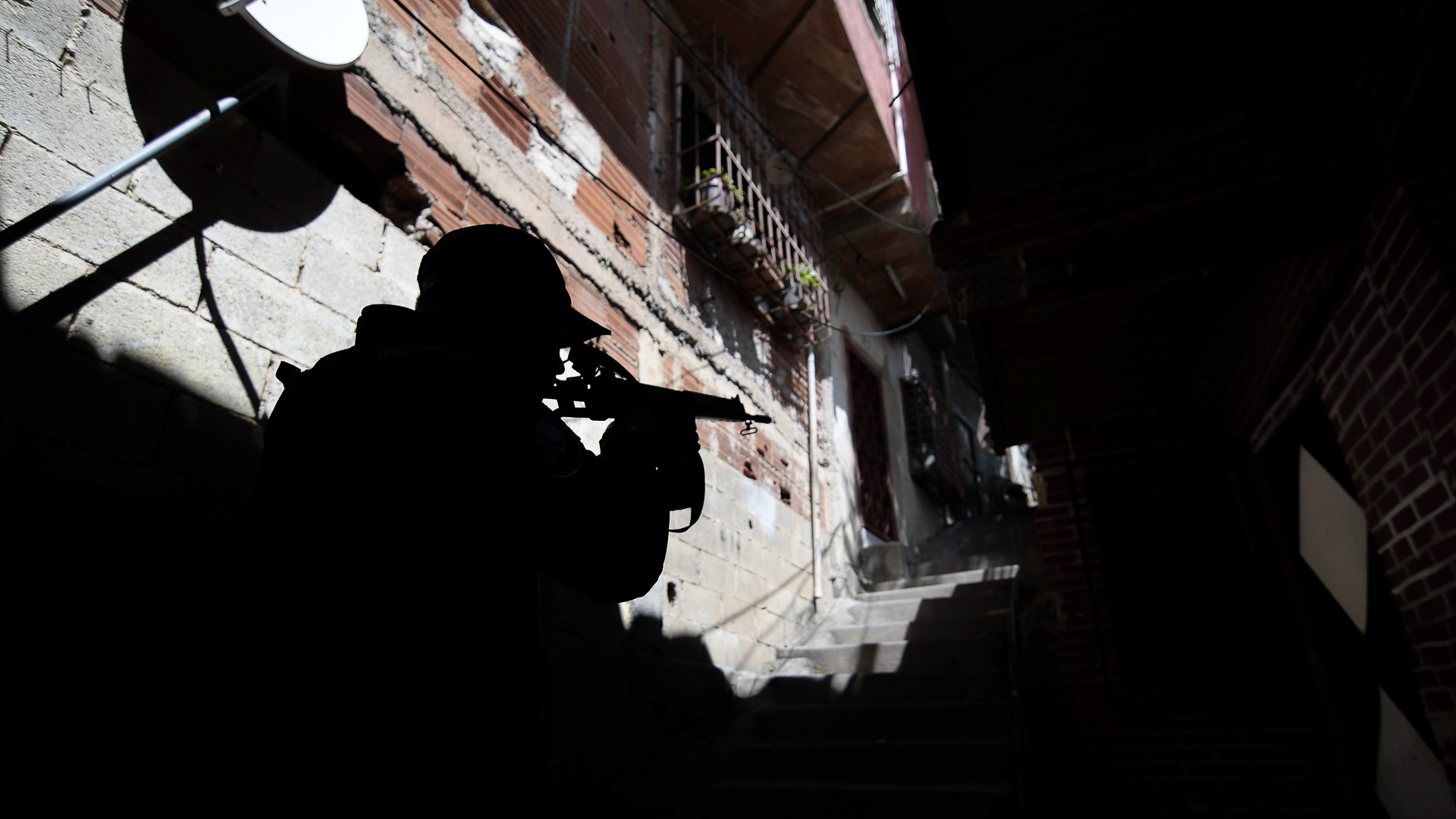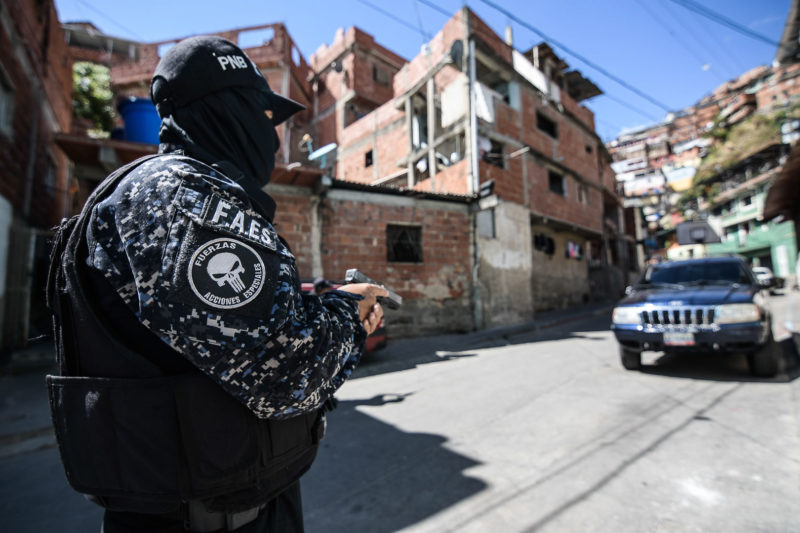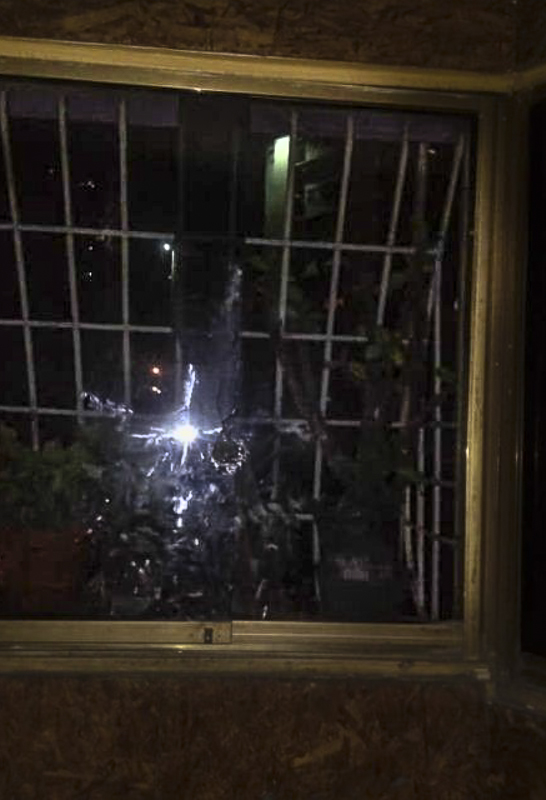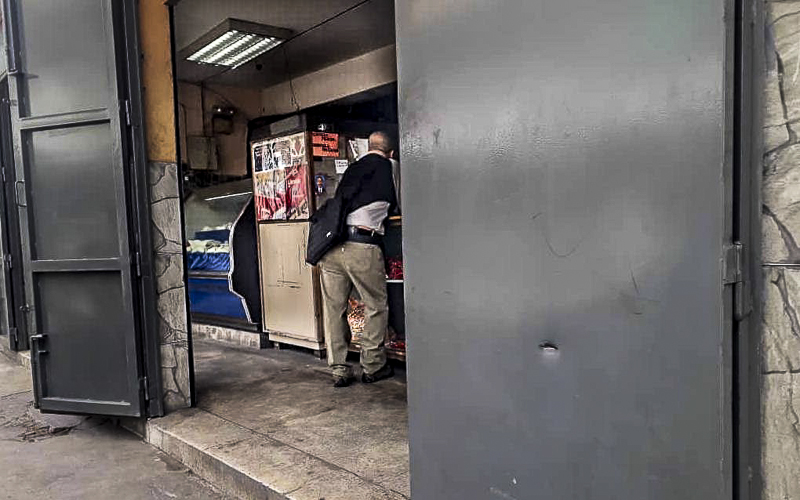

On the night of January 23, hours after congressman Juan Guaidó sworn in as interim president of the Republic, the Bolivarian National Police’s Special Action Forces (FAES, by its Spanish acronym) repressed protests in low-income areas that had been long considered strongholds of Chavismo. They arrived in Petare’s José Félix Ribas, instilling terror among neighbors. Journalist Genesis Carrero Soto shares her account of how she and her relatives lived through all the turmoil.
 Photographers: Román Camacho y Génesis Carrero Soto
Photographers: Román Camacho y Génesis Carrero Soto
“Come home now, please! There is a bunch of armed guys here and they say they’re going to take to the streets!”, my aunt yelled at the other end of the line, so desperately that I felt as though her words were dragging to where she was.
I hanged up and hurried as fast as I could through the unfinished businesses I had in the editorial office of the news portal where I work, which was bursting with news as much as the country on that afternoon of January 23, and 10 minutes before 7:00 pm, I arranged for a friend who rides a motorbike to take me home.
But it was already too late.
As we were riding along the Francisco Fajardo highway, east of Caracas, that dreadful stomach churn that comes with fear began to take hold of me. It was all pitch dark and there was glass and debris everywhere. We moved as fast as my friend could. At a certain distance from the Petare’s overpass one could only see that something very large had caught fire.
Just when we got beneath the road structure, as I was trying to adjust my eyes to the point that I could see that what burned ahead was an articulated truck, the phone and a flurry of gunfire rang in tandem.
“Mami, where are you? For Christ’s sake, don’t come home! Don’t come home! This is war!”
I told her, shouting, that I was already in Petare, but the noise of the gunshots on both ends of the telephone line curtailed all communication.
At that moment, out of nowhere, a man came out holding a gun, yelling at us to get the fuck out of there or else they would shoot us down. He did so while shaking the gun menacingly, but he was forced to take cover when another blast of heavy gunfire behind us caught him by surprise.
“The fucking FAES arrived”. That was the last thing I could hear before my friend started the motorcycle and an officer ordered him turn at the Cristo de Petare, that same large Christ figure that my aunt invoked and that stood there watching, still, the chaos that had unleashed at his feet.
On the bike, we wandered into the darkness that covered Petare like a mantle. I screamed and shouted that I needed to go back, that my family was back there, in José Félix Ribas, but my friend sped up and took me out of the slum.
Fear had already swept over me when, at 6:00 in the afternoon, I heard that protests had erupted in Petare. I know firsthand, because I have been there, that in the barrio where I live protests never end well. There are bottles flying and breaking, homemade explosives, gunshots, yelling, repression, looting, clashes… And darkness. Pitch darkness. And a lot of fear. Such are the ingredients of a demonstration in an underprivileged area, and on the afternoon of January 23 everything was set up for José Félix Ribas to turn into a minefield.
It is one of the 1,800 slums in the municipality of Sucre, in the state of Miranda. It is located in Petare, the place where the ‘Carakistán’ nickname by which the capital city is known was first coined and an area known as the most densely populated in the entire continent. It consists of 10 sectors clustered in 1 square kilometer of mountain, where about 120,000 citizens live all piled up on top of each other.
I have lived there, in one of those houses that stand barely separated from each other, for more than 10 years since I came to Caracas from the state of Aragua to study social communication. And that’s where my family lived the darkest hours the night after Juan Guaidó, a leader of the National Assembly, sworn in as interim president of Venezuela and the Special Action Forces took to the streets to repress anti-government protests that had erupted in low-income areas where Chavismo was once a very strong presence.
That afternoon of January 23, a group of people in José Félix set out to block the main street of Palo Verde. The protest took a different turn when armed civilians joined in and confronted the FAES with weapons of all kinds. That afternoon’s protests were a far cry from those of the opposition when it rallied for the first time in José Félix in 2017. Before that, Chavismo reigned in the community under the protection of the colectivo ‘La Fortaleza’ —a pro-government armed group that is based there— and strongly promoted by the supporters of the ruling party who followed the guidelines of the United Socialist Party of Venezuela in blind faith.
“We’re now in the room in the middle of the house; everyone is lying on the floor but the shots could get through the ceiling. I don’t know where to hide”, said my on the phone, but her crying and the detonations wouldn’t let her talk.
The roofs in the slums of Caracas are made of zinc sheets, and stray bullets always find a way in through them. My aunt knows it: the bullet holes that she has had to fill prove her right. That is why she knew that there was no choice but to drop to the floor, shield with something, and pray.
The shooting wouldn’t stop for at least three hours. In the meantime, I found shelter at a friend’s house near Petare, where I was far enough to be safe, but so close that I could still hear the detonations.
Each call from my aunt was a pound on my stomach.
“They ordered us to turn off the lights. They tell us that we can’t leave the house.”
I couldn’t even fathom what my people were feeling as they crawled across one of the smallest rooms in the house trying to take cover. I freaked out with the sound of the explosion of the first grenade, which I heard in a WhatsApp audio from a neighbor group, and it was as if I was there with them. That deep rumbling sound would mark a new cycle of events for the inhabitants of José Félix who, in the following days, would have to see how officers broke in, like hounds, looking for the thugs that fought them on the night of January 23 and the ammunition that they hide in the shanty-house ecosystem in the area.
I called my aunt and cousins every five minutes. They are the family that adopted me in Caracas, and to know that they were in danger was pure torture. I feared that they would break into the house, rob them or beat them. The thought of officers assailing neighbors was agonizing to me. And that is just what they have been doing in this new wave of protests in areas like Catia, El Limón or San Agustín, where they point their rifles at the protesters and the surrounding houses more than at those who can defend themselves with an arm.

“Mami, there is no end to this. I’m sure something got into the house. They shot at the house! I can’t look out to see what it is! They’re going to shoot me!”, said my aunt, and the call got cut off.
I was shaking on a piece of furniture in the living room of that other people’s house. I didn’t want to be there. I couldn’t be there. I needed to be with them. I tried to call about 15 times, but a system had already been activated to cut off communications in the slum area. No Twitter, no WhatsApp, no internet; nothing worked. Making a call and have it go through was an act of faith.
But the audios and videos had already begun to circulate and kept coming in, each more alarming than the other.
“They have vests, radios, machine guns, pistols. I don’t know who is the police and who is not “, said another resident of José Félix Ribas’ Zona 5. She, like so many others in the barrio, followed the order to turn the lights off, an order that nobody knew for sure who had given. She never looked out of the window, and when she did, it was as carefully as if she was looking at something that has been forbidden.
In the middle of the shooting, another neighbor reminded me of the protests of 2017 and how a series of businesses were looted at dawn several times. But I also lived through that and I never ever saw the demonstrators —a bunch of youngsters— throw nothing but stones and homemade explosives which were repelled by the National Guard with tear gas and rubber pellets.
Something different was going on this time. The people from the Penal Forum explained it this way: ‘Night darkness and attacks to underprivileged areas characterize the new wave of repression in Venezuela.’ Attorneys Gonzalo Himiob and Alfredo Romero, who lead this organization that defends political prisoners, have stated that there is a whole new pattern in the detention of protesters and that untrained police forces are being sent to contain public demonstrations with ‘warfare gear’.
I knew that because I had reported on them in other communities in Caracas since January 21, when the protests began. The night of January 23 I came to realize how true it is when people say that sometimes it’s better not to know. I was paralyzed by the thought that men dressed in black, heavily armed, with their pray-hunter animal fury, could break into my house.
I was already into my fifth Our Father when, after the roar of another grenade that had made me jump from the furniture, my aunt finally answered the call. It was her answering; her and no one else. Her voice stopped all my ugly thoughts. Her voice dissipated the fear that was rumbling in my head of someone else picking up and asking me to rush to some hospital.
It was already 11:00 pm. She told me that there were still people in the area wandering up and down but that they had stopped shooting because the explosion of the grenade had quieted everything down. José Félix looked like a ghost town. It was all darkness and calm after three hours of relentless shooting.
No neighbor dared to turn on a light that night.

The marks of the war were there lingering as a presage of what would happen the following days. That shot that my family heard was a shot from a FAL or from a shotgun that had entered the house, went through the glass window and could have hit any of them had it not been for that small room in the middle of the house where random objects were stored, which ended up being the bunker in which they found refuge.
At 6:00 in the morning of January 24, I finally got home and saw that another bullet had broken through the roof. On the streets, everyone was in a hurry, running errands, shopping, and no one spoke of the dead or wounded.
“I think that lots of kids were shot, but they’d better be cured at home because if they are taken to the hospital, those guys are going to finish killing them,” a merchant told me.
Others said that the war would resume that night. But danger came wearing uniform, driving armored trucks and in broad daylight. At 2:00 in the afternoon, the FAES entered the area and swept it and raided everything they found on their path from Zona 6 to Zona 9 of José Félix Ribas. The entire barrio witnessed how, in less than an hour, pickup trucks drove downhill filled with boys covered in blood, thrown into the back section of the vehicles.
The photos spoke to the world of what was happening all along the main street of José Félix Ribas, but tragedy had also struck people inside their homes.
“They came in like maniacs, kicked down doors and entered in as many houses as they could. They destroyed some of the houses; others, they robbed; and who knows how many dead people there were because an elderly man also died of a heart attack after those men broke into his house”, a woman told me while we waited for the subway on the platform of the Palo Verde station on the morning of January 25.
Mattresses were turned upside down, cabinets were destroyed, food packages were smashed open, windows and doors were left unhinged, and there were plates, containers and clothing everywhere. This is how numerous houses were left in Zona 6, the first sector that the FAES stormed into in their search —according to the neighbors— for the leader of the gang that confronted them on the night of January 23 and that kicked them out of José Félix.
The FAES were stationed in that Petare’s slum from January 23 to January 27. During that time, micro-buses and mototaxis wouldn’t go to the upper part, and all the shops would be closed by 12 noon. Street vendors have not returned to the sidewalks, and the streets —just as they were in that five-day story— are still plunged into darkness because the same men who trashed the light bulbs on the night of January 23 sow fear again among the brave people of José Félix that had decided to go out to protest.
Translation: Yazmine Livinalli
1961 readings
I am a Central University of Venezuela journalist trained in the old good times of the Últimas Noticias newspaper. I am a community reporter who tries to put the spotlight on what’s happening in our country’s slums. I am interested in writing about human rights violations and stories that prove that there are still good people in this world.